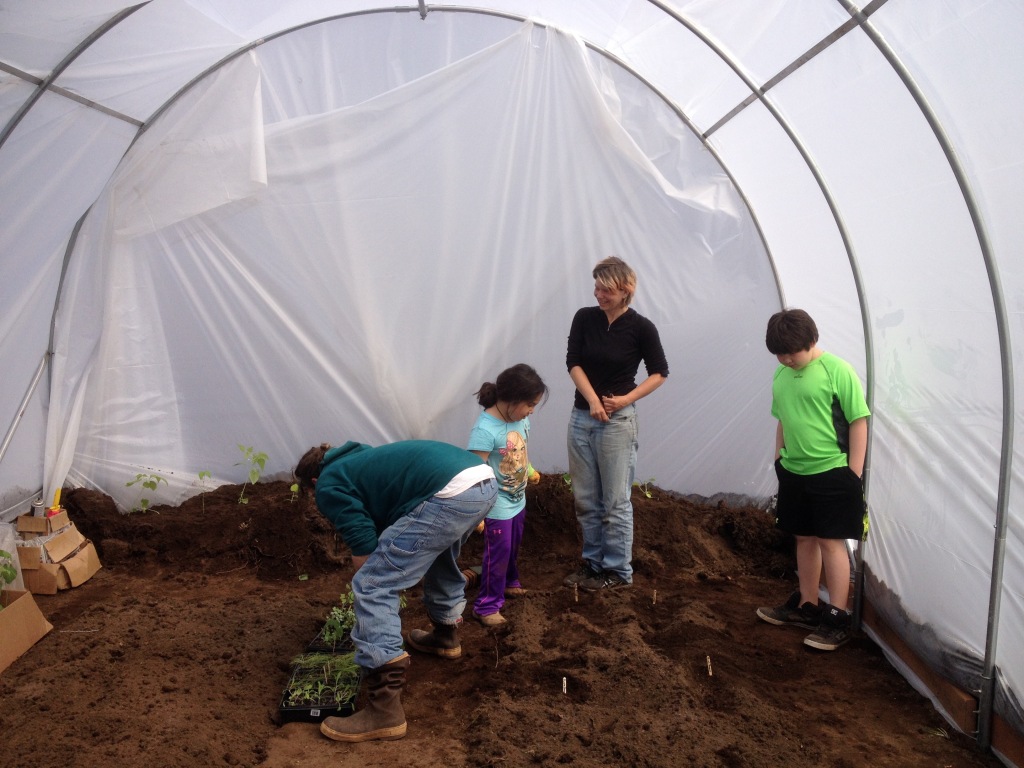Yarducopia Traveled to Port Heiden
Yarducopia was invited by the Native Village of Port Heiden this spring to help them start a garden. Exciting things are happening in the community! They have recently acquired a reindeer herd, chickens, meat rabbits, and pigs. They have constructed a fish processing plant, and the community has taken charge of their own PCB remediation and removal at the abandoned military site. The community is determined to be a vibrant, healthy, and economically viable place to live. They want their children to grow up with the same sense of belonging and place enjoyed for millennia and to have a relationship with a secure food supply. The enthusiasm of Adrianne Christiansen, business development director, toward these goals is contagious.

Port Heiden’s reindeer herd
I met with Adrianne over the winter and researched growing practices that might work in the region. Port Heiden is on the Alaska Peninsula near Aniakchak Caldera. It has a maritime climate that is quite a bit cooler and windier in the summer than Anchorage. Beautiful low tundra covers much of the ground, with some willows and larger vegetation in more wind-protected areas. Permafrost is generally absent and not a concern, and the volcanic origin of the soils is promising in regards to mineral content for plant growth. In April, Yarducopia sent out a box of seed starting materials and instructions and the children of the community very successfully started lettuce, beets, beans, summer squash, cabbage, broccoli and many other things in a south-facing window.
I flew down on Monday, May 23, using my frequent flyer miles to bring my 13 year old son. This was his first trip on a small plane and to an off-road-system community in Alaska and he was very excited. To make things work in a place off the road system in Alaska takes ingenuity, flexibility, and resilience. Port Heiden had been gifted a free high tunnel, but many pieces went missing in the transfer. Despite this, they had set up a strong metal framework by the time I arrived, and pieced together a replacement for the missing cover from builders plastic that was already there. On my end, a backpack with most of our dinners and the two boxes of vegetable starts I was bringing got bumped from our flights down due to weight limitations of the small planes. We waited to see if they would show up before the plants died in their dark, dry cardboard boxes and the frozen Costco burritos went bad.

Planting in the High Tunnel
Good, organic rich soil had been piled up on site waiting to make a garden. Tundra had been cleared and this good looking soil laid down inside and around the high tunnel. We are awaiting the results of a soil test, but the texture is good – a little heavy but very rich – about equal parts sand and clay/silt with a bit of gravel and the deep chocolate color that indicated high organic content. We loosened the soil in permanent beds inside the tunnel and added more loose soil on top. The kids sprinkled lime to make the soil less acidic (a general condition of Alaskan soils) and we planted starts, potatoes and seeds. I brought a small amount of Arctic Organics organic fertilizer mix (I believe it is composed of wood ash, bone meal and fish meal) and we sprinkled that around the cabbage and other heavy feeding plants. A smaller plastic greenhouse was also set up, protected from the wind by a metal structure for meat chickens and the bigger high tunnel. We prepared the soil in this one and planted some tomatoes and other warm weather crops.
Finally, a protected place next to the office building was found to build a sheet mulch garden. This area had tall, lush grass indicating a warm and protected micro-climate and was very near the front door, allowing easy garden access and viewing. We laid down cardboard and topped it with collected straw and manure from the chicken house. Then we put a few inches of local soil on top and the kids sprinkled on the lime again! We planted it with hardy brassicas and the Yarducopia starts that finally made it out on Wednesday, and looked pretty good for spending two and a half days in the dark! A fence was put up around it to keep dogs, foxes, bears, etc from running across it. We will need to see if parka (arctic ground) squirrels are a concern – do they like to eat fresh veggies too?
While we were there, the weather was unusually good. Wind stayed generally less than 20 mph, and the sun shone more often than not. The high tunnel and greenhouse were toasty and calm. It was very apparent that wind protection was the number one thing that could help with vegetable growing success. Some cool weather crops may actually be too hot under the plastic. Unfortunately, the makeshift plastic high tunnel cover started to fail under the constant worrying of a shifting wind, and as we left for our plane on Friday, it was clear that a new, stronger cover system would have to be implemented. Yarducopia hopes to be able to travel back out in the fall for the Food Security Conference and to evaluate what is working best to fine tune the gardening system for next year.
Whatever happens, the next generation in Port Heiden is learning valuable skills to add to the subsistence skills they are already learning – the children were so excited to put plants in the ground, to eat the starts we had to thin (young beets, lettuce, cabbage and onions all went into every helpers mouth with cries of ‘yum!’), to feed the chickens and bring in the eggs for sale. It is a hopeful thing to see and I can’t wait to come back!

Planting the Sheet Mulch Bed – ATV Helmet Optional :)

